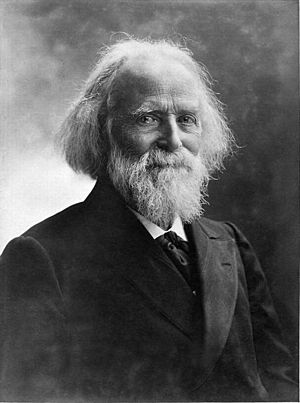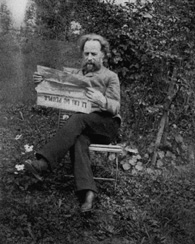Élisée Reclus facts for kids
Quick facts for kids
Élisée Reclus
|
|
|---|---|
 |
|
| Born | 15 March 1830 Sainte-Foy-la-Grande, Gironde, France
|
| Died | 4 July 1905 (aged 75) Torhout, Belgium
|
| Alma mater | University of Berlin |
| Occupation | Geographer, anarchist revolutionary, and writer |
Jacques Élisée Reclus (born March 15, 1830 – died July 4, 1905) was a famous French geographer, writer, and a thinker who believed in freedom and equality for everyone. He is best known for his huge 19-volume book called Universal Geography, which took him almost 20 years to write (from 1875 to 1894). This amazing work earned him a special gold medal from the Paris Geographical Society in 1892. This was quite remarkable because he had been asked to leave France due to his strong political ideas.
Contents
Early Life and Education
Élisée Reclus was born in Sainte-Foy-la-Grande, a town in France. He was the second son in a large family of fourteen children. His father was a Protestant pastor. Many of his brothers, including Onésime and Élie Reclus, also became well-known writers or thinkers.
Reclus started his education in Germany. He later studied at a Protestant college in France and finished his studies at the University of Berlin. There, he spent a long time learning about geography from a famous professor named Carl Ritter.
Travels and Early Works
Because of political problems in France in 1851, Reclus left the country. For the next six years (1852–1857), he traveled and worked in many different places. He visited Great Britain, the United States, Central America, and Colombia.
In 1853, he arrived in Louisiana, USA. He worked there for about two and a half years as a tutor for his cousin's children on a plantation near New Orleans. He wrote about his experiences traveling through the Mississippi River Delta and his thoughts on Louisiana before the American Civil War. This was published in 1855 as Fragment d'un voyage à la Nouvelle-Orléans.
When he returned to Paris, Reclus wrote many articles for magazines like Revue des deux mondes. These articles shared what he had learned from his geography studies. During this time, he also wrote a short book called Histoire d'un ruisseau (Story of a Stream). In this book, he described how a big river develops from its small beginning to its mouth. From 1867 to 1868, he published another important work, La Terre; description des phénomènes de la vie du globe (The Earth; Description of the Phenomena of the Life of the Globe).
Political Involvement and Exile
During the Siege of Paris (1870–1871), Reclus helped with balloon operations. He also served in the National Guard. He supported the Paris Commune of 1871, which was a revolutionary government in Paris. He even published a strong statement against the French government in a newspaper called Le Cri du Peuple.

Because of his involvement, Reclus was captured on April 5, 1871. In November, he was sentenced to be sent away from France for life. However, with help from his supporters in England, his sentence was changed in January 1872. Instead of being sent away, he was permanently banned from France.
Life in Switzerland and Major Work
After a short visit to Italy, Reclus moved to Clarens, Switzerland. There, he continued his writing. He wrote Histoire d'une montagne (Story of a Mountain), which was a companion book to his earlier Story of a Stream.
It was in Switzerland that he wrote almost all of his most famous work, La Nouvelle Géographie universelle, la terre et les hommes (Universal Geography, the Earth and Humans). This huge project looked at every continent and country. It explored how geographical features like rivers and mountains affected human populations, and how humans, in turn, affected their environment. The book was filled with many maps, plans, and pictures. It won the gold medal from the Paris Geographical Society in 1892. Reclus's writings were known for being very accurate and well-explained, making them valuable for both science and literature.
Beliefs and Later Life
Reclus had strong beliefs about personal freedom. In 1882, he wrote a pamphlet called Unions Libres, where he shared his ideas about relationships and marriage. He believed people should have the freedom to choose how they live their lives and form relationships.
In 1894, Reclus became a professor of comparative geography at the Free University of Brussels in Belgium. He moved there with his family. His brother, Élie Reclus, was already teaching at the university. Élisée Reclus continued to write many important articles and essays for scientific journals in French, German, and English. In 1894, he also received the Patron's Medal from the Royal Geographical Society.
Shortly before he passed away in 1905, Reclus finished his last major work, L'Homme et la terre (Humanity and the Earth). In this book, he brought together his earlier ideas by looking at how humans have developed in relation to their geographical surroundings.
Personal Life
Élisée Reclus was married and had two daughters. He died in Torhout, a town near Bruges, Belgium.
Legacy and Impact
Many important thinkers of the 19th century admired Reclus, including Alfred Russel Wallace and Patrick Geddes.
Reclus was a strong supporter of nature conservation. He also believed in treating animals kindly and was a vegetarian. Because of these ideas, some historians believe his thoughts were ahead of his time. They see his ideas as similar to modern movements like social ecology, which looks at how humans and nature interact, and the animal rights movement.
See also
- Anarchism in France
- Green anarchism
 In Spanish: Élisée Reclus para niños
In Spanish: Élisée Reclus para niños


